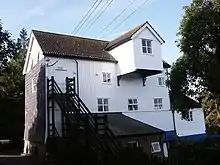Little Hallingbury
Little Hallingbury is a small village and a civil parish in the Uttlesford district of Essex, England.


Geography
Little Hallingbury parish is on a high rise of ground and contains the small settlements of Gaston Green, Wright's Green and Mott's Green to the south of Little Hallingbury village. It is bordered at the west by the River Stort over which are the Hertfordshire parishes of Sawbridgeworth and Thorley. The parish of Hatfield Broad Oak borders the east, Hatfield Heath and Sheering the south, and Great Hallingbury the north. The M11 motorway runs north to south through the parish.
Community

The parish church of St Mary the Virgin on Wright's Green Lane in Wrights Green is a Grade II* listed church dating to the 12th century, with flint rubble, tile and Roman brick walls, and a 19th-century bell turret with an octagonal spire;[1] the associated Church of England voluntary aided primary school is also on Wright's Green Lane. Little Hallingbury village hall is on the A1060 Lower Street in Wright's Green.[2] Further south on Lower Street beyond the M11 is a site with an equestrian centre and a MOT test centre. The George Inn on Latchmore Bank is the village public house, a Grade II listed timber framed and plastered building dating to at least the 17th century.[3]
Little Hallingbury Cricket Club represents the civil parish of Little Hallingbury, with its home ground at Gaston Green.[2] The club plays in the Herts and Essex League, and fields Saturday, Sunday, mid-week and junior teams.
Little Hallingbury Mill, to the west of Gaston Green, is a Grade II* converted watermill,[4] which today is a small hotel and restaurant. The current mill was built in 1874, although there was milling on this site for many years before it was converted to a hotel. Although not in commercial use, the mill machinery is in working condition.
Hatfield Forest in neighbouring Hatfield Broad Oak has been a Royal Hunting Forest from the time of the Norman kings. The forest is open to the public and covers 1,049 acres (4 km2) of woodland, grassland with trees, lake and marsh. Portingbury Hills in Hatfield Forest is suggested to be a defended settlement or farmstead dated to the Iron Age. According to the National Trust "The main rectangular mound is approximately 100 by 70 feet (30 by 21 m) and is surrounded by a ditch 25 to 35 feet wide, with a flat top.".[5][6]
See also
References
- Historic England. "Church of St Mary the Virgin (Grade II*) (1112021)". National Heritage List for England. Retrieved 10 November 2018.
- "Clubs and societies", Little Hallingbury Parish Council. Retrieved 10 November 2018
- Historic England. "The George (Grade II) (1308505)". National Heritage List for England. Retrieved 10 November 2018.
- Historic England. "Hallingbury Mill (Grade II*) (1111991)". National Heritage List for England. Retrieved 24 November 2017.
- Bettley, James; Nikolaus Pevsner, Essex: Buildings of England Series Yale University Press, ISBN 978-0-300-11614-4 p.480
- "The history of Hatfield Forest through the Ice-Bronze-Iron-Age ", The National Trust "National Trust | Hatfield Forest | History | Pre-hunting forest". Archived from the original on 29 June 2011. Retrieved 4 March 2011.
External links
 Media related to Little Hallingbury at Wikimedia Commons
Media related to Little Hallingbury at Wikimedia Commons- St Mary the Virgin's Church, Little Hallingbury
- Little Hallingbury Parish Council
- Little Hallingbury Cricket Club